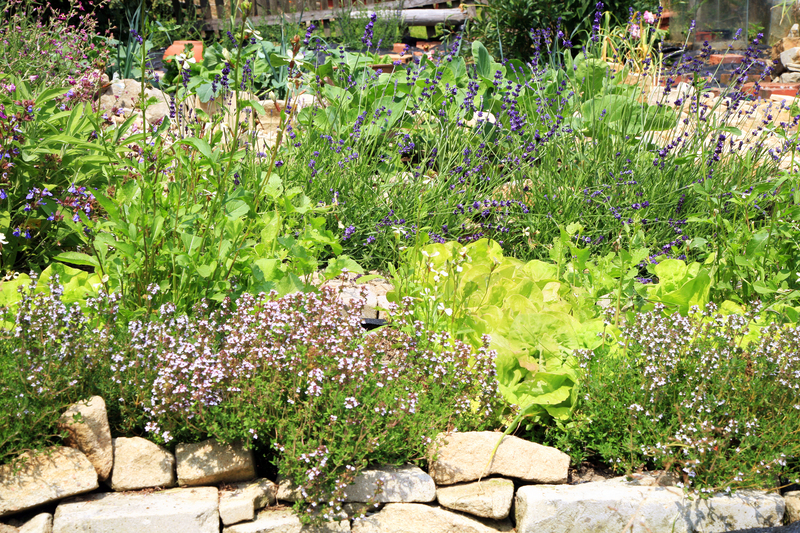Your Pathway to Transforming a Neglected Garden
Posted on 03/09/2025
Your Pathway to Transforming a Neglected Garden: The Ultimate Guide
Are you gazing out at a weed-riddled, overgrown patch of earth and wondering how it could ever become a lush, vibrant oasis? Transforming a neglected garden might seem daunting, but with a little knowledge, planning, and perseverance, you can breathe new life into your outdoor space. This comprehensive guide will walk you step-by-step along your pathway to transforming a neglected garden, offering expert tips, and practical solutions for every stage of the journey.

Why Bother Reviving a Neglected Garden?
Before diving into the how, let's consider the benefits of restoring a neglected garden:
- Enhanced Property Value: A lovely garden can significantly increase your home's appeal and worth.
- Personal Satisfaction: Witness your efforts bloom (literally) in a space you can relax and enjoy.
- Environmental Impact: Green spaces foster biodiversity, improve air quality, and combat climate change.
- Physical & Mental Health: Gardening is a proven way to reduce stress and stay active.
Assessing the Extent of Neglect
The First Step: Garden Inspection
Your neglected garden transformation journey must begin with a comprehensive inspection. Don't just look from afar--walk through your garden and take detailed notes:
- Which areas are the most overgrown or damaged?
- Are there any existing structures (sheds, fences, raised beds) that could be repaired or removed?
- Do you spot any invasive weeds or diseased plants?
- What's the state of the soil -- is it compacted, eroded, or dry?
- Are there trees or shrubs worth saving?
Snap some 'before' photos. These will inspire you later and help you track progress. Remember, every garden has potential, no matter how overgrown or forlorn it may seem.
Clearing the Way: Remove Debris and Weeds
Dealing with Weeds and Overgrowth
The next step on your pathway to garden restoration is a big clean-up. Equip yourself with sturdy gloves, secateurs, a weed puller, and perhaps some rubbish bags or a skip.
- Remove Rubbish: Bag up litter, broken pots, old tools, and any other junk cluttering your garden.
- Cut Back Overgrowth: Trim back unruly bushes, pull out brambles and vines, and mow any tall grass.
- Dig or Fork Out Weeds: Focus on roots to prevent regrowth; for large plots, consider a mechanical tiller.
- Dispose of Green Waste Responsibly: Compost healthy plant matter; avoid composting weeds with seeds or diseased plants.
Safety First!
Watch out for sharp objects, insect nests, and hidden hazards. If tackling stubborn or hazardous weeds (like Japanese knotweed), seek advice from local experts.
Soil Revival: Preparing for Growth
Testing and Improving Your Soil
No garden transformation is complete without healthy, fertile soil. Once your plot is cleared, assess the soil:
- Is it sandy, clayey, or loamy?
- Does it drain well, or is it waterlogged?
- Is it acidic or alkaline? (Home soil testing kits are affordable and easy to use)
- Add organic matter: Well-rotted compost, leaf mould, or manure will rejuvenate tired soil.
- Break up compaction: Use a fork to aerate heavy, compacted areas.
- Add sand or grit for clay soils to enhance drainage.
- Lime can be used to reduce acidity; sulfur to lower pH, but always follow soil test recommendations.
A little investment here will pay off tenfold in plant health and garden productivity.
The Vision: Planning Your New Garden
Design with Purpose
Now comes the exciting part: planning your new garden. The best garden makeovers start with a plan--no matter how simple.
- Purpose: Will your garden be for relaxing, entertaining, growing food, or wildlife?
- Style: Do you love traditional cottage gardens, sleek modern lines, or wild nature?
- Budget: Decide how much you can invest in new plants, hard landscaping, and tools.
- Sun and Shade: Watch how sunlight moves through your garden and choose plants accordingly.
- Zones: Map out areas for dining, play, composting, or vegetable patches.
Sketch a basic plan or use online garden design tools. This is your opportunity to make the most of your space and express your creativity!
Hard Landscaping and Pathways
Setting the Stage
Before you plant, sort out the 'bones' of the garden. Hard landscaping includes patios, decks, fences, walls, edging, and paths. Good pathways make a garden feel welcoming and complete.
- Repair or replace broken fencing and gates.
- Lay stepping stones, gravel, or recycled woodchip paths to define walkways.
- Clear and restore patios, or create new sitting areas for relaxing.
- Install raised beds for vegetables if the soil is poor or to make gardening easier.
Tip: Hard landscaping doesn't have to be expensive. Upcycle old bricks, logs, or paving slabs. Get creative and eco-friendly!
Choosing Plants for a Revived Garden
Start Simple
If your garden has been neglected for a long time, start with easy, hardy plants that will survive tough conditions while you continue improving soil and structure.
- Tough Perennials: Geraniums, daylilies, hostas, and ornamental grasses.
- Shrubs: Hydrangea, spirea, and dogwood add year-round interest.
- Native Plants: Benefit local wildlife and require less maintenance.
- Fast-Growing Annuals: Sunflowers, nasturtium, and marigolds give a pop of color while you plan longer-term projects.
Creating Garden Layers
Aim for variety: tall plants at the back, medium in the middle, and groundcover at the front. This maximizes interest and makes your garden feel lush and full.
Prioritize Easy Wins
You don't need to plant everything at once. Focus on a couple of high-impact areas -- perhaps by the patio or near the entrance -- for instant gratification and motivation.
Watering and Mulching Strategies
Efficient Watering for Neglected Gardens
A restored garden, especially in its first year, needs regular watering. Install simple systems like a hose timer, drip irrigation, or water butts to collect rainwater.
- Water early in the morning or late evening to reduce evaporation.
- Focus on the root zone rather than leaves.
- Newly planted areas will require more frequent watering.
Mulch for Moisture and Suppression
Mulching is a neglected garden's best friend. A 2-3 inch layer of bark chips, wood shavings, or compost will:
- Suppress further weed growth
- Conserve soil moisture
- Insulate roots against temperature extremes
- Add organic matter as it breaks down
Encouraging Wildlife into Your Restored Garden
The pathway to transforming a neglected garden isn't just about plants -- it's about creating an ecosystem:
- Plant nectar-rich flowers for bees and butterflies
- Include berry or nut bushes for birds
- Install a bug hotel or leave some logs for beetles
- Add a small pond or birdbath for water
- Avoid pesticides -- let nature do the work!
You'll soon find your garden bustling with life, making it more vibrant, healthy, and enjoyable.
Maintaining Momentum: Establishing Good Habits
Simple Tasks, Big Results
Consistent, small efforts are the secret to keeping your reclaimed garden thriving:
- Weekly Weeding: Stay on top of new growth before it gets out of hand.
- Regular Watering: Especially in dry spells or for new plants.
- Pruning: Trim plants to encourage healthy growth and more flowers.
- Feeding: Use organic fertilizer or compost for a nutrient boost.
- Mulch Top-Ups: Replace and refresh as needed to keep weeds at bay.
Tip: Spend just 10-20 minutes a day or a couple of hours on weekends. Set reminders if needed!
Common Challenges & How to Overcome Them
Dealing with Persistent Weeds
Some gardens are overrun with weeds like bindweed or ground elder. Don't despair:
- Stay diligent. Remove weeds as you see them--roots and all.
- Lay thick cardboard under mulch as a weed barrier in problem spots.
- In extreme cases, consider professional help for invasive species.
Managing Limited Time & Budget
Transforming a neglected garden doesn't need to break the bank. Reclaim and reuse materials, propagate new plants from cuttings, or swap with neighbors. Gradual improvement is perfectly fine -- enjoy the process!
Seasonal Tips for Ongoing Success
- Spring: Plant new perennials and sow annual seeds. Check for winter damage and prune shrubs as needed.
- Summer: Water deeply, weed regularly, and enjoy the blooms. Deadhead faded flowers to encourage more.
- Fall: Plant bulbs for next spring, rake leaves, and mulch beds.
- Winter: Clean and store tools, plan for the next season, and review your garden's progress with those 'before' and 'after' photos!

Inspiration: Real-Life Garden Recoveries
Many have walked this path before you. Whether it's a small urban yard or an expansive country plot, transformed gardens share a common story: with patience and vision, even the most neglected garden can become a paradise.
Success stories often begin with small victories--perhaps a single blooming rose from a bush you nearly discarded, or the chirping of birds in your newly planted hedgerow. Use their stories as motivation when the work feels overwhelming.
Conclusion: Start Your Journey Today
Every neglected garden has the potential for transformation. The pathway to success is clear: assess, clear, nourish, plan, plant, nurture, and maintain. You don't need to tackle everything overnight. Each small step brings you closer to the lush, welcoming garden you've always wanted.
Ready to begin your pathway to transforming a neglected garden? Start today and let nature reward you with color, life, and tranquility. With every weed pulled and every flower planted, you're not just gardening--you're creating a space for joy, relaxation, and renewal.

